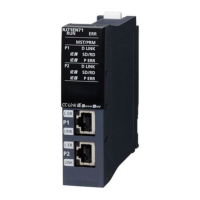744
7 APPLICATION INSTRUCTIONS
7.18 PID Instruction
■Determining the three PID constants (limit cycle method) [Reference]
To obtain good control result of PID control, optimal values of individual constants (parameters) appropriate to the controlled
system need to be determined. Here, the limit cycle method is explained as a method of determining the amplitude (a) and
vibration cycle (,
on
) of the input values and calculating the proportional gain (K
P
), integral time (T
I
), and derivative time (T
D
)
using the expressions provided in "operation characteristics and three constants" below.
• Limit cycle method
This method determines three PID constants by measuring a change generated in the input value when two-position control
(outputting the output upper limit value (ULV) and output lower limit value (LLV) by switching them according to the error) is
performed.
• Operation characteristics (example of reverse action)
For the duration of
W
after the end of tuning cycle, the manipulated value (MV) is held at the output lower limit value (LLV)
and the operation transitions to normal PID control.
W
can be determined by (50+K
W
)/100 (-
on
), and the wait setting parameter (K
W
) can be set in parameter (S3)+28.
(Setting range K
W
= -50 to 32717[%], Operating as
W
=0 when an abnormal range is specified)
• Operation characteristics and three constants
(SH
PV
): PV input threshold value (hysteresis)
Control mode Proportional gain (K
P
) [%] Integral time (T
I
) [100ms] Derivative time (T
D
) [10ms]
Proportional control (P
operation) only
PI control (PI operation)
PID control (PID operation)
τ0 τ1 τ2
τ
τon
τw
a
MV
(upper limit)
(lower limit)
Time
Time [s]
SV
Input value
ULV
LLV
SV
+SHPV
SV-SHPV
a
0.9
(ULV-LLV) × 100
⎟
⎠
⎞
-×
τ
τ
τ
on
on
133
⎟
⎠
⎞
⎟
⎠
⎞
-×
τ
τ
τ
on
on
120
⎟
⎠
⎞
⎟
⎠
⎞
-×
τ
τ
τ
on
on
150
⎟
⎠
⎞

